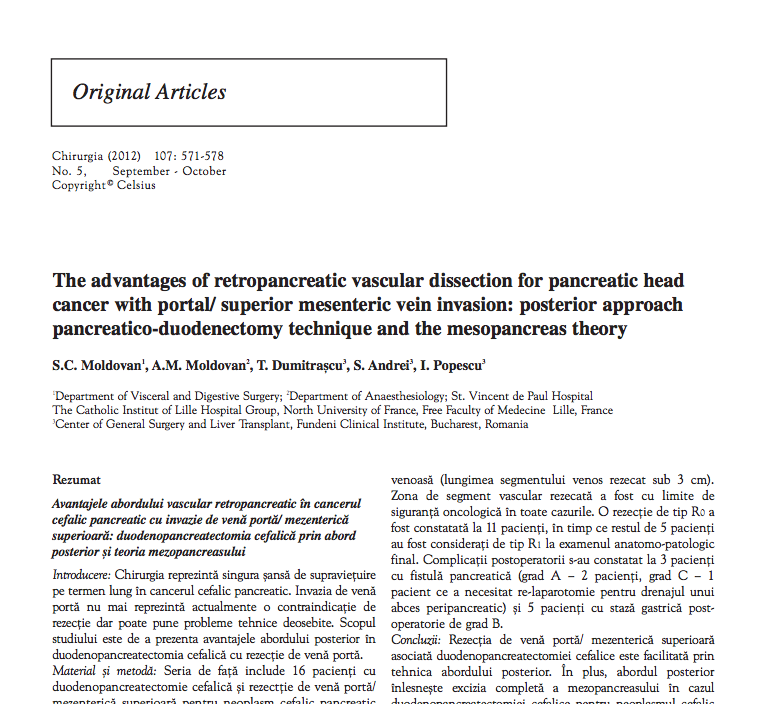Autori:
S.C. Moldovan1, A.M. Moldovan2, T. Dumitraæcu3, S. Andrei3, I. Popescu3
1Department of Visceral and Digestive Surgery; 2Department of Anaesthesiology; St. Vincent de Paul Hospital
The Catholic Institut of Lille Hospital Group, North University of France, Free Faculty of Medecine Lille, France
3Center of General Surgery and Liver Transplant, Fundeni Clinical Institute, Bucharest, Romania
The Catholic Institut of Lille Hospital Group, North University of France, Free Faculty of Medecine Lille, France
3Center of General Surgery and Liver Transplant, Fundeni Clinical Institute, Bucharest, Romania
Rezumat:
Background/Aims: Surgery remains the single hope for long-term survival long-term survival in pancreatic head carcinoma. Portal vein invasion is no longer a contraindication for resection but could be technically challenging. The aim of the present study is to emphasize the advantages of the posterior approach in duodenopancreatectomy with portal vein resection.
Methods: The present series includes 16 patients with duodenopancreatectomy and portal/superior mesenteric vein resection and reconstruction duodenopancreatectomy invading the venous axis, performed from 2004 to 2011, and representing one author’s experience.
Results: A lateral resection with direct suture was performed in 10 patients and the length of the resected venous wall was less than 1.2 cm. A segmental resection was performed in six patients and the length of resected vein did not exceed 3 cm (range, 1.5 – 3 cm). All venous resection extremities were cancer-free at final pathological report. Eleven patients were considered as R0 resection while 5 patients were assessed as R1 at final pathological examination. Postoperative morbidity consisted of: 3 patients with postoperative pancreatic fistulae (grade A – 2 patients; grade C – 1 patient, requiring second look laparotomy for peri-pancreatic abscesses) and 5 patients with delayed gastric emptying grade B.
Conclusion: Portal/superior mesenteric vein resection during duodenopancreatectomy is safe and it is facilitated by the posterior approach. Moreover, the posterior approach facilitates total mesopancreas excision during duodenopancreatectomy for pancreatic head cancer, a technical feature that appears to be associated with an increased rate of negative resection margins.
Methods: The present series includes 16 patients with duodenopancreatectomy and portal/superior mesenteric vein resection and reconstruction duodenopancreatectomy invading the venous axis, performed from 2004 to 2011, and representing one author’s experience.
Results: A lateral resection with direct suture was performed in 10 patients and the length of the resected venous wall was less than 1.2 cm. A segmental resection was performed in six patients and the length of resected vein did not exceed 3 cm (range, 1.5 – 3 cm). All venous resection extremities were cancer-free at final pathological report. Eleven patients were considered as R0 resection while 5 patients were assessed as R1 at final pathological examination. Postoperative morbidity consisted of: 3 patients with postoperative pancreatic fistulae (grade A – 2 patients; grade C – 1 patient, requiring second look laparotomy for peri-pancreatic abscesses) and 5 patients with delayed gastric emptying grade B.
Conclusion: Portal/superior mesenteric vein resection during duodenopancreatectomy is safe and it is facilitated by the posterior approach. Moreover, the posterior approach facilitates total mesopancreas excision during duodenopancreatectomy for pancreatic head cancer, a technical feature that appears to be associated with an increased rate of negative resection margins.
Chirurgia (2012) 107: 571-578
[gview file=”https://www.chirurgiehbp.ro/wp-content/uploads/2016/08/ARCHBPTH004-1.pdf”]

